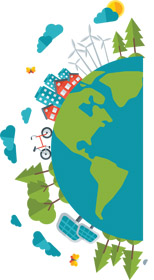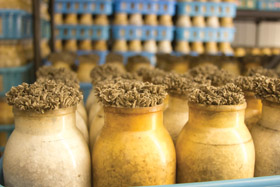Waste Not, Want Not
By 2025, Marin County wants its residents and businesses to meet its zero waste goal by reducing and recycling solid wastes and collecting and safely disposing of hazardous materials. While the responsibility rests on the shoulders of its citizens, Zero Waste Marin was created as a watchdog and shepherd to collaborate with the county’s municipalities and make measureable milestones that ensures the county meets its goal in time.
Zero Waste Marin is comprised of city and town managers of Corte Madera, Fairfax, Mill Valley, Belvedere, San Anselmo, Ross, Sausalito, San Rafael and Tiburon. The Marin County Department of Public Works/Waste Management administers the group, which surpassed the state’s 50 percent mandate and posted a 62.3 percent diversion rate in 2000, positioning the Regional Agency as a state leader in recycling and waste reduction.
Waste efficiency is a group effort, and Marin County decided to tackle the issue head-on so future Marinites can enjoy a life without worrying about waste.
Earth Friendly Labware
Labcon North America was founded in Marin County in 1959. Now more than 50 years later, it’s grown to supply more than 800 products to medical and research labs all over the world.
In 1995, the company began to develop products that incorporated concepts of eco-efficiency, using less packaging, recycled plastics and refillable packages, like the Pagoda pipet tip reloading system. This product eliminates 90 percent of packaging and waste typical to products of this kind and has inspired many imitations.
It then created a micro-centrifuge tube that uses half the plastic of other tubes but still can be boiled without opening, called the SuperClear. A solvent-free system prints 15ml and 50ml centrifuge tubes so there are no volatile organic compounds vented to the atmosphere.
In 2010, the company installed an 800kw rooftop solar array. When it went operational in 2011, it provided about 30 percent of the energy needed to produce Labcon products; and now provides 33 percent. Today, Labcon products carry the “Made with Solar Power” trademark.
Labcon’s sustainable use practices continue in the North Bay and will hopefully inspire many other businesses follow the lead.
A New Way to Grow
 Mushroom farms smell terrible. It’s the cost of doing business when the product is a fungus. “Typical commercial-grade farms use manure to feed their mushrooms, which generates a rather unfortunate aroma,” says Justin Reyes, sales manager for Gourmet Mushrooms in Sebastopol, which cultivates their produce by mixing soil with plant matter leftover from commercial agriculture and their own onsite garden. “This farm operates cleaner, more efficiently and produces some very high quality mushrooms over other large-scale farms.”
Mushroom farms smell terrible. It’s the cost of doing business when the product is a fungus. “Typical commercial-grade farms use manure to feed their mushrooms, which generates a rather unfortunate aroma,” says Justin Reyes, sales manager for Gourmet Mushrooms in Sebastopol, which cultivates their produce by mixing soil with plant matter leftover from commercial agriculture and their own onsite garden. “This farm operates cleaner, more efficiently and produces some very high quality mushrooms over other large-scale farms.”
Cornhusks, leftover foods and oyster shells are ground and mixed with the soil to create a fertile mix for the mycelium, the underground nerve system of the mushroom. After the soil is mixed, it’s packed into reusable plastic jars then sent to an oven for heat sanitization to ensure outside bacterium doesn’t interfere with the growing fungus. After spores are introduced, the mushrooms are stacked in crates and carefully monitored in a cool, temperature controlled warehouse. After the edible fruit of the mushroom peaks through the substrate, they’re taken to various storage rooms where a gentle mist helps hydrate and cultivates the mushrooms before they’re removed from the jars and packaged for sale.
“We only need to water the mushrooms once when the spores are introduced, then only sparingly during the growing phase,” Reyes says. “After we cut the substrate out of the jar and harvest the mushroom, the soil is reintroduced to the mill, where we re-enrich it with our plant matter so it can be used again.”



